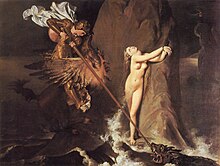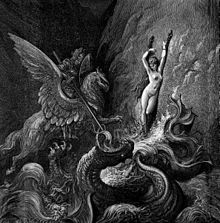| This article needs additional citations for verification. Please help improve this article by adding citations to reliable sources. Unsourced material may be challenged and removed. Find sources: "Angelica" character – news · newspapers · books · scholar · JSTOR (December 2009) (Learn how and when to remove this message) |

Angelica is a princess in the epic poem Orlando innamorato by Matteo Maria Boiardo. She reappears in the saga's continuation, Orlando furioso by Ludovico Ariosto, and in various later works based on the two original Orlando pieces. The narratives are part of the Matter of France, a cycle of legendary history stories based on the adventures of Charlemagne and his paladins. She is mentioned in chapter 6 of Mary Shelley's Frankenstein (1818).
Orlando Innamorato
In Orlando Innamorato, Angelica is introduced as the daughter of Galafrone, the king of "Cathay" or "India". Cathay commonly refers to China, not India, but this seeming inconsistency can be resolved: Boiardo considered Cathay to be a city, and "Cathay was a city in India inferior or Serica" according to the Mappamondo Borgiano. She comes to Charlemagne's court with her brother Argalia (who assumes the identity of a knight named Uberto dal Leòne). All the knights are smitten with her, especially the cousins Orlando (Roland) and Rinaldo (Renaud), but the protective Argalia will only allow her to marry a man who can best him in a joust. When Argalia eventually falls to the Saracen knight Ferraù, Orlando and Rinaldo threaten to destroy each other over her. As the Saracens lay siege to Duke Naimon's estate, Charlemagne promises Angelica's hand to whichever cousin fights best for him. The battle is lost, however, and the characters go on to further adventure: Rinaldo and Angelica drink from magic fountains twice, each time leaving one madly in love and the other indifferent, while Orlando loses his wits to his passion.
Orlando Furioso

Boiardo left his epic unfinished, but the action was taken up in Orlando furioso. Angelica is continually sought throughout the world by Orlando, Rinaldo, and the best knights from various countries. She eventually finds herself naked and chained to a rock in the sea, offered as a sacrifice to a sea monster called the orc (a situation identical to the perils of Andromeda). She is rescued by the African knight Ruggiero, who gives her a ring of invisibility. Later, pursued by the lovelorn Orlando, she uses the ring and vanishes. She ultimately falls in love with an ordinary North African soldier named Medoro, who she nurses back to health, and returns with him to Cathay. Orlando goes mad when he learns of their marriage from a shepherd and his wife. He requires the aid of his cousin Astolpho to recover his senses. Cured entirely of his love, Orlando stops his search for Angelica, and she no longer appears in the poem.
Notes
- Galafrone's realm is vast, with Cathay as its capital city. Albraca a fortress, a day's journey west.
References
- Citations
- "Angelica". britannica.com. Retrieved 1 March 2017.
- Ross 2004, pp. 603–4 (notes on "Cathay")
- Paratico, Angelo (29 October 2016). "A Chinese Beauty in a Renaissance Poem at the time of Leonardo Da Vinci". Gingko. Archived from the original on 10 July 2018. Retrieved 10 July 2018.
citing Ponte, Givovanni
- Ponte, Giovanni (1972). La personalità e l'opera del Boiardo. Tilgher-Genova.
- Cavallo 2013, p. 47, p. 49 and notes 15, 16 (on p. 283).
- Ross 2004 (tr.), Orlando in Love, I.i. and p. 671. note to I.i.25.
- Bibliography
- Cavallo, Jo Ann (2013), The World Beyond Europe in the Romance Epics of Boiardo and Ariosto, University of Toronto Press, ISBN 9781442646834
- Boiardo, Matteo Maria (2004). Ross, Charles Stanley (trans.) (ed.). Orlando innamorato: Orlando in Love. Parlor Press LLC. ISBN 9781932559019.
| King Charlemagne and the Matter of France | |
|---|---|
| Key people | |
| Paladins and other characters |
|
| Horses and other animals | |
| Swords and other objects | |
| Places | |
| Chansons de geste and other works | |
| Ludovico Ariosto's Orlando Furioso | |
|---|---|
| Fictional characters | |
| Historical figures | |
| Source | |
| Films |
|
| Opera |
|
| Art |
|
| Related | |